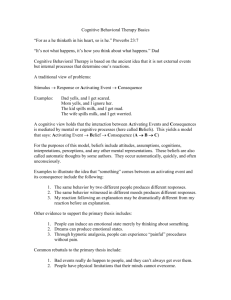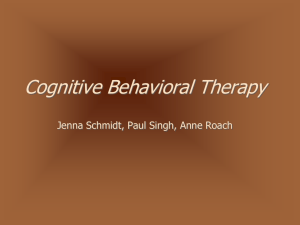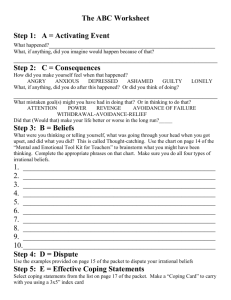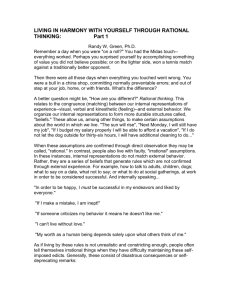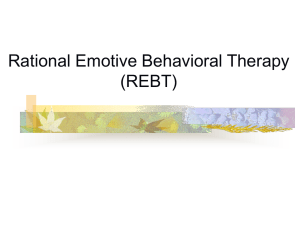chapter10
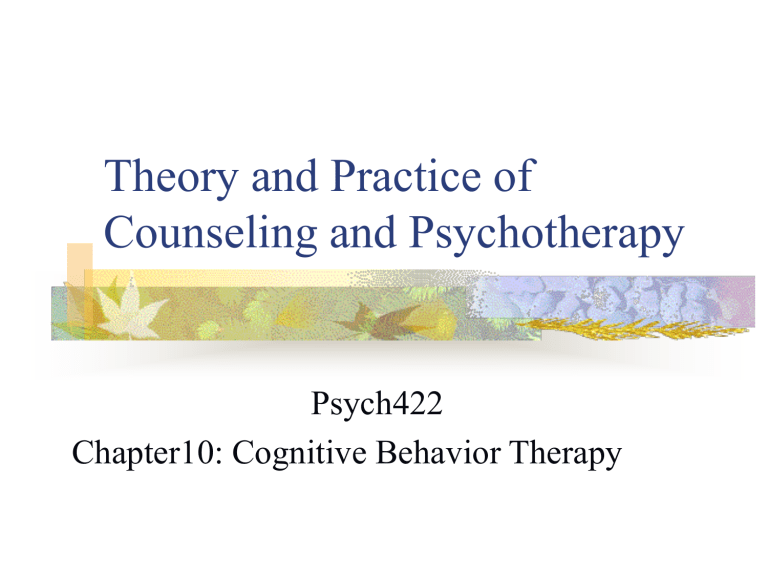
Theory and Practice of
Counseling and Psychotherapy
Psych422
Chapter10: Cognitive Behavior Therapy
Rational Emotive Behavioral Therapy
(REBT)
Stresses thinking, judging, deciding, analyzing, and doing
Assumes that cognitions, emotions, and behaviors interact and have a reciprocal cause-and-effect relationship
Is highly didactic, very directive, and concerned as much with thinking as with feeling
Teaches that our emotions stem mainly from our beliefs, evaluations, interpretations, and reactions to life situations
View of Human Nature
We are born with a potential for both rational and irrational thinking
We are self-talking, self-evaluating, and selfsustaining.
We have an inborn tendency toward growth and actualization
We learn and invent disturbing beliefs and keep ourselves disturbed through our self-talk
We have the capacity to change our cognitive, emotive, and behavioral processes
View of Emotional Disturbance
We learn irrational belief from significant other during childhood
Teach clients to feel undepressed even when they are unaccepted and unloved by significant others.
Blame is at the core of most emotional disturbances
Irrational idea (e.g., I must be loved by everyone)
internalize
self-defeating
We have a tendency to make ourselves emotionally disturbed by internalizing self-defeating beliefs
The A-B-C theory of personality
Case discussion 1
Tom, a college sophomore, want to overcomes his shyness around women. He doe not date and even des his best to keep away from women because he is afraid they will reject him. But he want to change this pattern.
Using A-B-C-D-E-F to analyze and help Tom
Case discussion 2
Mary would like to take a course in creative writing, but she fears that she has no talent. She is afraid of failing, afraid of being told that she is dumb, and afraid of follow through with taking the course.
Using A-B-C-D-E-F to analyze and help
Mary
Case discussion 3
Each week John comes to his sessions with a new excuse for why he has not succeeded in following through with his homework assignments. Either he forgets, gets too busy, gets scared. Or puts it off—anything but actually doing something to change what he says he wants to change. Instead of really doing much of anything, he whines each week about how rotten he feels and how he so much would like to change but just doesn’t know how.
What are the possible irrational beliefs, which keep
John from taking actions
What homework assignment might you suggest?
Case discussion 4
Brent feels that he must win everyone’s approval.
He has become a “super nice guy” who goes out of his way to please everyone. Rarely does he assert himself, for fear that he might displease someone who then would not like him.
What are the possible irrational beliefs?
How do you help Brent?
If Brent is Asian American, what cultural components you might take into account?
Irrational Ideas
Irrational ideas lead to self-defeating behavior
Some examples:
“I must have love or approval from all the significant people in my life.”
“I must perform important tasks competently and perfectly.”
“If I don’t get what I want, it’s terrible, and I can’t stand it.”
The Therapeutic Process
Therapy is seen as an educational process
Clients learn
To identify and dispute irrational beliefs
To replace ineffective ways of thinking with effective and rational cognitions
To stop absolutistic thinking, blaming, and repeating false beliefs
Therapeutic Goals
A basic goal is to teach clients how to change their dysfunctional emotions and behaviors into health ones.
Two main goals of REBT are to assist clients to achieving unconditional self-acceptance and unconditional other acceptance.
As clients become more able to accept themselves, they are more likely to unconditionally accept others.
Therapist’s function and Role
1. Encouraging clients to discover their irrational beliefs and ideas
2. Making connection of how these irrational beliefs lead to emotional disturbances
3. Challenging clients to modify or abandon their irrational beliefs.
4. Dispute the irrational beliefs and substitute rational beliefs and behaviors.
Client’s Experience in Therapy
A learner---learn how to apply logical thoughts, experiential exercises, and behavioral homework to problem solving and emotional change.
Focus on here-and-now experiences
Not spend much time to exploring clients’ early history and connecting present and past
Expect to actively work outside the therapy sessions.
Relationship Between Therapist and Client
Intensive therapeutic relationship is not required. But,
REBT unconditionally accept all clients and teach them to unconditionally accept others and themselves. (accept them as persons but confront their faulty thinking and selfdestructive behaviors)
Ellis believes that too much warmth and understanding can be counter-productive, fostering dependence for approval.
Therapists shows great faith in their clients’ ability to change themselves.
Open and direct in disclosing their own beliefs and values
Transference is not encouraged, when it occur, the therapist is likely to confront it (e.g., clients believe that they must be liked and loved by their therapists.)
Therapeutic techniques and procedures
Cognitive methods
Disputing irrational beliefs
If I don’t get what I want, it is not at the end of the world
Doing cognitive homework
Applying ABC theory in daily life’s problems
Put themselves in risk-taking situations to challenge their self-limiting beliefs.
Replace negative self-statement to positive message
Changing one’s language
It would be absolutely awful..
It would be inconvenient
Using humor
Humorous songs
Therapeutic techniques and procedures
Emotional Techniques
Rational-emotional imagery
Imagine the worst things that could happen to them
Role playing
Shame-attacking exercises
Take a risk to do something that they are afraid to do because of what others might think…until they realize that their feelings of shame are self-created.
Use of force and vigor
From intellectual to emotional insight
Reverse role playing
Therapeutic techniques and procedures
Behavioral Techniques
Use most of the standard behavioral therapy approaches.
Research Efforts
Most studies focus only on cognitive methods and do not consider emotive and behavioral methods.
Applications of REBT
REBT has been widely applied to several areas: anxiety, depression, psychotic disorders, problems of sex, love, and marriage, crisis, couple and family therapy…
Aaron Beck’s Cognitive Therapy (CT)
Insight-focused therapy
Emphasizes changing negative thoughts and maladaptive beliefs
Theoretical Assumptions
People’s internal communication is accessible to introspection
Clients’ beliefs have highly personal meanings
These meanings can be discovered by the client rather than being taught or interpreted by the therapist
Theory, Goals & Principles of CT
Basic theory:
To understand the nature of an emotional episode or disturbance it is essential to focus on the cognitive content of an individual’s reaction to the upsetting event or stream of thoughts
Goals:
To change the way clients think by using their automatic thoughts to reach the core schemata and begin to introduce the idea of schema restructuring
Principles:
Observe a utomatic thoughts, identify cognitive distortions, and ask for evidences for reality testing the cognitive distortions
CT’s Cognitive Distortions
Arbitrary inferences
Making conclusions without supporting and relevant evidence
Selective abstraction
Forming conclusions based on an isolated detail of an event
Overgeneralization
Based on one single incident and applying them to dissimilar events
CT’s Cognitive Distortions
Magnification and minimization
Perceiving a case or situation in a greater or lesser light than it truly deserves
Personalization
Relate external events to themselves even when there is no basis for the connection.
Labeling and mislabeling
Portraying one’s identity on the basis of imperfections or mistakes made in the past
Polarized thinking
Thinking in all-or-nothing terms
The Client-Therapist Relationship
Therapeutic relationship is necessary, but not sufficient, to produce therapeutic effect.
Encourage clients to take an active role in selfdiscovery.
Aim to teach client how to be their own therapist, educate clients about the nature of their problem, about the process of cognitive therapy, and how thoughts influence their emotions and behaviors.\
Use homework to test their beliefs in daily-life situations
CT’s Cognitive Triad
Pattern that triggers depression:
1. Client holds negative view of themselves and blames themselves
2. Selective abstraction: Client has tendency to interpret experiences in a negative manner
3. Client has a gloomy vision and projections about the future
Application of CT
Treatment of depression and anxiety
Managing stress, in parent training, and in treating various clinical disorders
Donald Meichenbaum’s Cognitive
Behavior Modification (CBM)
Focus:
Changing client’s self-verbalizations or selfstatements
Premise:
As a prerequisite to behavior change, clients must notice how they think, feel, and behave, and what impact they have on others
Basic assumption:
Distressing emotions are typically the result of maladaptive thoughts
Meichenbaum’s CBM
Self-instructional therapy focus:
Trains clients to modify the instructions they give to themselves so that they can cope
Emphasis is on acquiring practical coping skills
Cognitive structure:
The organizing aspect of thinking, which seems to monitor and direct the choice of thoughts
The “executive processor,” which “holds the blueprints of thinking” that determine when to continue, interrupt, or change thinking
How Behavior Changes?
3 Phases of Behavior Change
1. Self-observation
Listen to themselves, realize they contribute to their depression through how they think, and develop new cognitive structures
2. Starting a new internal dialogue
See adaptive behavioral alternatives
3. Learning new skills
Teaching more effective coping skills
Coping Skills Programs
Coping skills programs – Stress inoculation training (3 phase model)
1. The conceptual phase
Creating a working relationship with clients
2. Skills acquisition and rehearsal phase
Giving coping skills to apply to stressful situations
3. Application and follow-through phase
Transfer change to real world
From a multicultural perspective
Contributions
Diverse populations
appreciate the emphasis on cognition and actions
Challenge rigid thinking (e.g., “should”) instead of questioning the values
Stress the relationship of individuals to the family, community, and systems
From a multicultural perspective
Limitations
Exploring core beliefs is important in CBT-
needs to sensitive to cultural background and context
Value “working hard” feel ashamed for not living up to the expectations; divorce
bring shame to her family
Diverse clients may be hesitant to question their basic cultural values
Diverse clients may value interdependence and may feel difficult to be independent
Summary and Evaluation
Contributions
REBT: focus on how we interpret and react to the events; put insight into action; teach clients ways to carry out their own therapy without depending on therapists
CT: research support that CT is as empirically validated treatment; focus on a detailed case conceptualization to understand clients; is an eclectic psychotherapy
Summary and Evaluation
Limitations
Ellis: being too confrontational; ignoring “past”; power imbalance
CT: focusing too much on positive thinking, being too simplistic, denying past, being too techniqueoriented, failing to use the therapeutic relationship, working only to reduce symptoms, failing to explore the underlying causes of difficulties, ignoring unconscious factors and emotions.
